The Cherry G80-3494 MX Board Silent Mechanical Keyboard Review: Updating a PC Classic
by E. Fylladitakis on September 20, 2017 8:00 AM EST- Posted in
- Peripherals
- Keyboard
- Cherry MX
- Mechanical Keyboards
The Cherry G80-3494 MX Board Silent Mechanical Keyboard
A first look at the Cherry G80-3494 MX Board Silent reveals an oversized, tall keyboard with a plastic body, with the only thing visually separating it from common 80s keyboards being its black color. It takes a closer inspection by an advanced user to reveal that this is a high quality mechanical keyboard, or an experienced eye to recognize the legendary Cherry G80 design.
We received the US layout version of the Cherry G80-3494 MX Board Silent. It adheres fully to the 104 keys ANSI layout, without any extra keys or modifications. It has a 6.25× Spacebar and seven 1.25× bottom row keys. Cherry is using a classic font on the keycaps, with the letters identical to their first G80 keyboards from the early 90’s but with sharper punctuation marks. There are no extra keys, no keystroke combinations, not any kind of advanced functions.
The Cherry G80-3494 MX Board Silent is a relatively tall keyboard but not too tall, designed for maximum typing comfort. It is just tall enough to allow for comfortable typing without the user’s wrists touching the desk or the keyboard. For long typing sessions though, a proper wrist rest will most likely be a necessity to professionals.
Beneath the keyboard we find only two small tilt adjustment feet. The feet are made of clear plastic. Despite their size, they are surprisingly good at holding the large keyboard firmly in place.
Removing some of the keycaps reveals the new Cherry MX Silent switches. These switches are the new variant of the original Cherry MX linear switches that have been redesigned to limit their noise output, which can be a major problem in some applications. Last year we saw the first commercial keyboards featuring these switches when we reviewed the Corsair Strafe RGB. Our Cherry G80-3494 MX Board Silent sample features the black variant of the switch, which is a little stiffer.
Opening up the plastic body of the Cherry G80-3494 MX Board Silent is very easy, as there are hardly any screws to be found on the keyboard. Almost everything is held together with plastic locks and clips. A small screwdriver or other similar tool is more than enough to undo the clips and crack open the plastic body of the keyboard. Inside the keyboard we found a classic black PCB with the mechanical switches attached to it.
There is nothing advanced on this PCB; there are only the switches and a few passive components, with most of them being classic film resistors. A basic USB controller chip can be found on the small green PCB at the top right side of the keyboard, where the three indicator LEDs are. There is no onboard memory or advanced microcontrollers to be found here, as they would not serve any purpose and counter this keyboard’s intended design, which is based on maximizing its reliability.
As best as anyone at AnandTech can recall, this is the first mechanical keyboard that we have seen to not have a metal frame/support for the switches. Instead it relies entirely on the PCB for mechanical cohesion. It probably is not as resistant against heavy physical blows, yet it should be more than sufficiently sturdy for typical everyday use. What frustrated us is the extensive dead space inside the keyboard’s plastic body, which, in an example of just how far technology has progressed in the last couple of decades, is enough space to fit an entire modern low-power PC. Cherry obviously wanted to keep the keyboard’s frame unchanged as it has been out for decades but, on the other hand, that is a lot of space being wasted there.


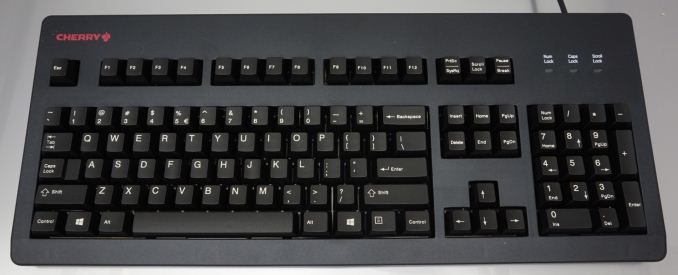
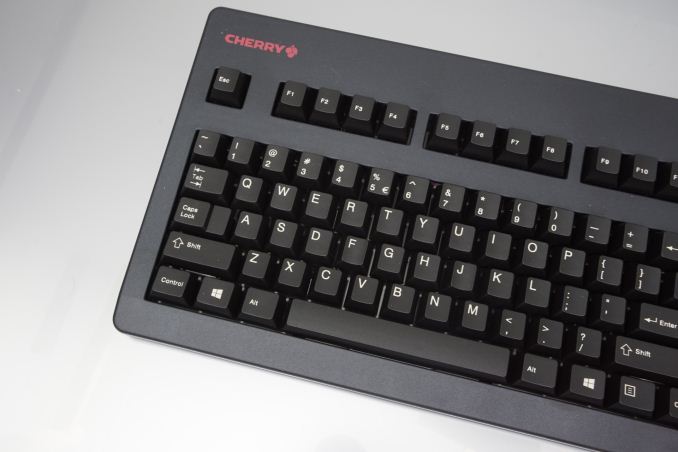
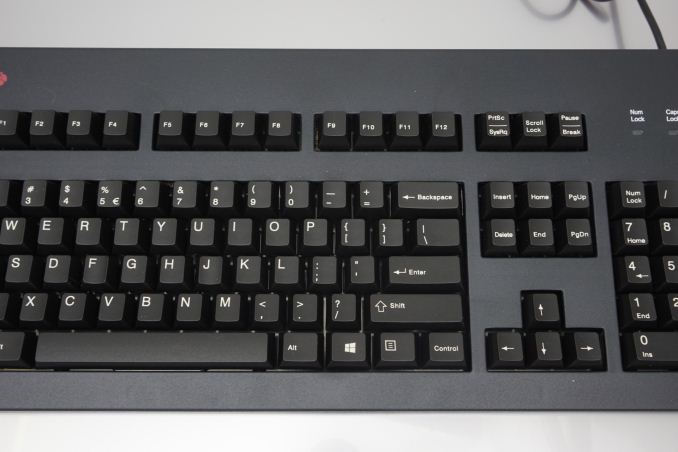
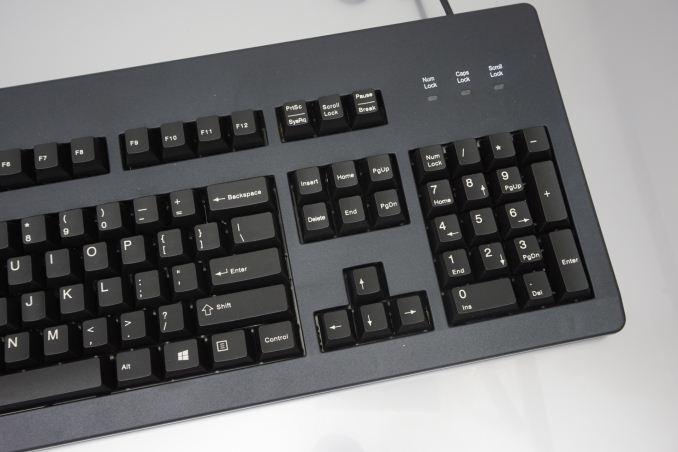
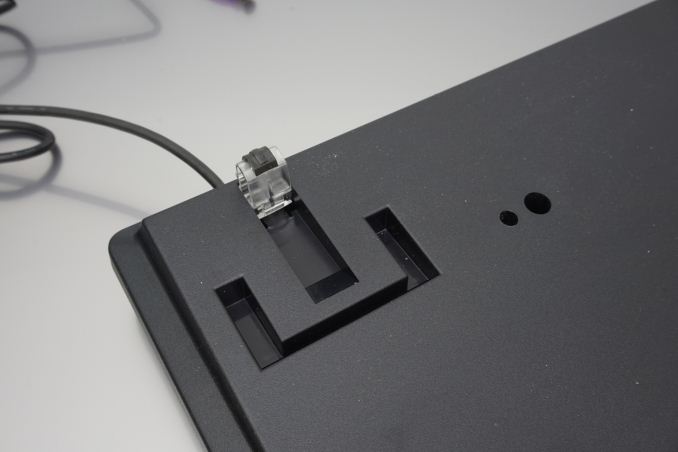

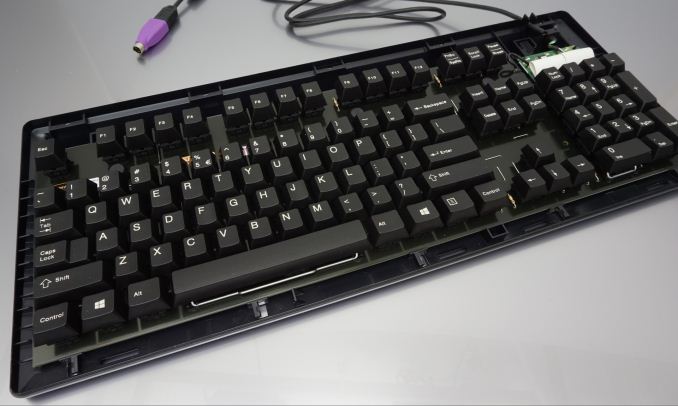








51 Comments
View All Comments
Ninhalem - Wednesday, September 20, 2017 - link
This keyboard is designed very similarly to my second generation DasKeyboard. In fact the internal shots are almost identical compared to the Das, even down to those stiff ribbon cables connecting the PCB switch board to the microchip board. One of the improvements they need to make is putting big strips of rubber on the bottom to prevent sliding on desks.Gothmoth - Wednesday, September 20, 2017 - link
"his keyboard is designed very similarly to my second generation DasKeyboard"more the other way around...
HStewart - Wednesday, September 20, 2017 - link
Probably so - since Cherry is one that make the keys - but this is first time I heard of them having actual keyboard.Keep in mind, one thing these keyboards are not just for desktops, I use a DasKeyboard on my Lenovo Y50 notebook and love it. Most of time it connected to keyboard and have it connected to Samsung 4K monitor - I do use it as laptop but for this laptop that is rare.
I wish I had more of these keyboards - they are perfect for me. There also portable enough if I need to travel with it. I guess that is why they are call some laptops, desktop replacements
Wolfpup - Wednesday, September 20, 2017 - link
Yeah, I use keyboards with Cherry MX Browns on my notebooks.MamiyaOtaru - Wednesday, September 20, 2017 - link
"but this is first time I heard of them having actual keyboard."come on man
"This keyboard is an especially interesting item to review because rather than being a wholly new design, it's a new iteration on a classic design, following in the footsteps of the original iconic Cherry G80-3000 series keyboards that have been in circulation for decades."
the one they mention has been around since 1988 - https://deskthority.net/wiki/Cherry_G80-3000
Ninhalem - Wednesday, September 20, 2017 - link
Err no. I bought this DasKeyboard in 2005. Certainly the switches are Cherry MX Blue's but the design of the keyboard setup itself, where the control board is placed, where the cord exits the casing, and how the control board and the switch PCB board are connected, those are all design decisions.MamiyaOtaru - Wednesday, September 20, 2017 - link
and the older Cherry board this is based on came out in 1988 so...Alexvrb - Wednesday, September 20, 2017 - link
LOL this reminds me a little of arguing with an Apple fan about a "new" feature.Flunk - Wednesday, September 20, 2017 - link
1988 came before 2005? You don't say.bigboxes - Thursday, September 21, 2017 - link
You may as well stop while your behind